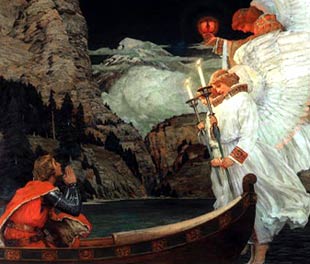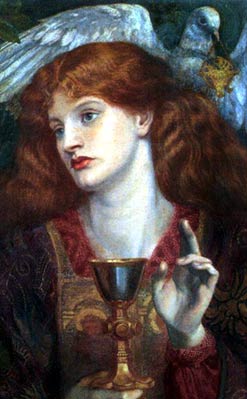
The
Knight of the Holy Grail
Frederick J. Waugh,
1912
`For
on a day she sent to speak with me.
And when she came to speak, behold her eyes
Beyond my knowing of them, beautiful,
Beyond all knowing of them, wonderful,
Beautiful in the light of holiness.
And "O my brother Percivale," she said,
"Sweet brother, I have seen the Holy Grail:
For, waked at dead of night, I heard a sound
As of a silver horn from o'er the hills
Blown, and I thought, `It is not Arthur's use
To hunt by moonlight;' and the slender sound
As from a distance beyond distance grew
Coming upon me—O never harp nor horn,
Nor aught we blow with breath,
 or
touch with hand, or
touch with hand,
Was like that music as it came; and then
Streamed through my cell a cold and silver beam,
And down the long beam stole the Holy Grail,
Rose-red with beatings in it, as if alive,
Till all the white walls of my cell were dyed
With rosy colours leaping on the wall;
And then the music faded, and the Grail
Past, and the beam decayed, and from the walls
The rosy quiverings died into the night.
So now the Holy Thing is here again
Among us, brother, fast thou too and pray,
And tell thy brother knights to fast and pray,
That so perchance the vision may be seen
By thee and those, and all the world be healed."
Excerpt from: 'The Holy Grail'
by: Alfred, Lord Tennyson |
 The
grail concept familiar to us today
has evolved through the centuries within the Arthurian story cycles.
The legends of the questing knights risking all to attain the Grail
gathered increasing embellishments through the writings of Chrétien,
Wolfram von Eschenbach and later Thomas Malory. Original elements from
Welsh and Irish lore blended with French and German motifs, while later
Christian aspects transformed nearly all obvious pagan references. The
grail concept familiar to us today
has evolved through the centuries within the Arthurian story cycles.
The legends of the questing knights risking all to attain the Grail
gathered increasing embellishments through the writings of Chrétien,
Wolfram von Eschenbach and later Thomas Malory. Original elements from
Welsh and Irish lore blended with French and German motifs, while later
Christian aspects transformed nearly all obvious pagan references.
 The
earliest written account of the Grail is accepted as the French verse of Chrétien
de Troyes, entitled 'Conte del Graal', translated literally as: 'The Story of the
Grail'. Chrétien's version was completed in the late twelfth century. Over the next
several decades variations of the original tale appeared throughout the region.
The most prominent of these is the German 'Parzifal' by Wolfram von Eschenbach,
completed around 1220. More than two centuries later Sir Thomas Malory's 'Morte
d'Arthur,' 'The Death of Arthur,' focused upon the deeds of the Arthurian knights.
This vivid collection of tales would serve as the primary source of later nineteenth
century writers. The
earliest written account of the Grail is accepted as the French verse of Chrétien
de Troyes, entitled 'Conte del Graal', translated literally as: 'The Story of the
Grail'. Chrétien's version was completed in the late twelfth century. Over the next
several decades variations of the original tale appeared throughout the region.
The most prominent of these is the German 'Parzifal' by Wolfram von Eschenbach,
completed around 1220. More than two centuries later Sir Thomas Malory's 'Morte
d'Arthur,' 'The Death of Arthur,' focused upon the deeds of the Arthurian knights.
This vivid collection of tales would serve as the primary source of later nineteenth
century writers.
 Despite
the naturally diverse interpretations of its aspect and nature,
what remains constant is the power of renewal inherent within the Grail.
In the early texts, the 'greal' (as a platter) is a provider of food
and nourishment in appropriate need to each individual. To those who
reside within its presence, the grail traditionally provides healing
and sustenance. The constant allure is its promise of renewal, a transformative
renewal, often perceived as a means of attaining immortality. Equally
constant in the tales is the question of worthiness. Even the finest
and most courageous of Arthur's knights proved unworthy and were denied
communion. A valuable literary lesson for contemporary seekers. Despite
the naturally diverse interpretations of its aspect and nature,
what remains constant is the power of renewal inherent within the Grail.
In the early texts, the 'greal' (as a platter) is a provider of food
and nourishment in appropriate need to each individual. To those who
reside within its presence, the grail traditionally provides healing
and sustenance. The constant allure is its promise of renewal, a transformative
renewal, often perceived as a means of attaining immortality. Equally
constant in the tales is the question of worthiness. Even the finest
and most courageous of Arthur's knights proved unworthy and were denied
communion. A valuable literary lesson for contemporary seekers.
|





